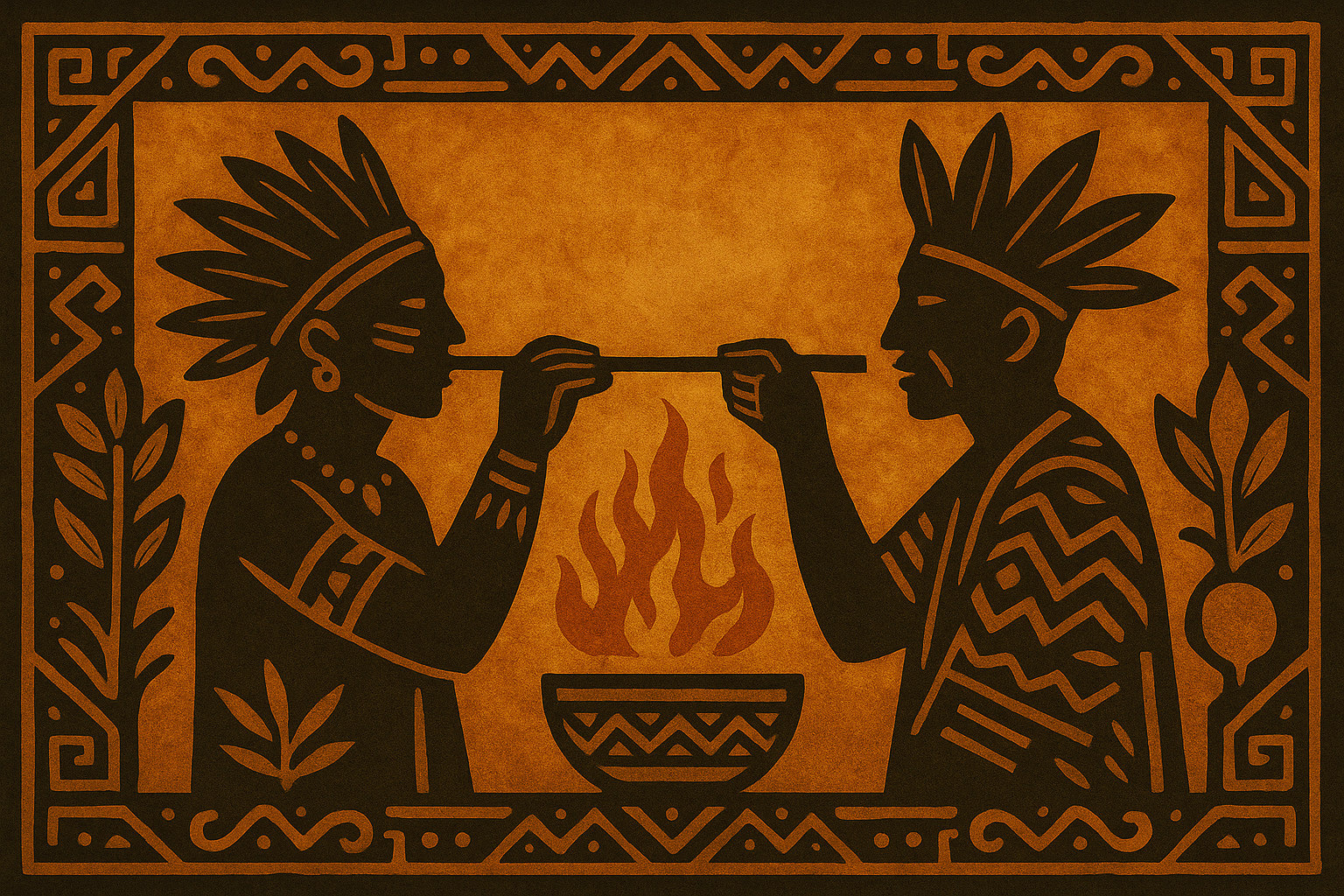The hapé ceremony is not merely the act of blowing a sacred snuff through the nostrils. It is a portal — a sacred rite that connects the human spirit with the forest, the ancestors, and the great mystery. ✨
In this guide, we’ll explore the spiritual essence of a hapé ceremony, how it’s traditionally performed, and how you can engage with it respectfully and powerfully.
What is a hapé ceremony?

A hapé ceremony is a traditional Amazonian ritual that uses hapé (or rapé) — a finely ground powder made from Nicotiana rustica and other sacred ashes — to cleanse, realign and awaken the spiritual body.
🔥 Key elements of a hapé ceremony:
- Intention is everything. The hapé is a vehicle for transformation, not entertainment.
- Silence and breath are sacred tools. The moment of blowing is the beginning of the ritual, not the end.
- Connection to the forest: Each blow invokes the spirit of the plants, the ancestors, and the invisible realm.
“Hapé is not a product — it is a prayer in powder form.”
Sacred purposes of hapé in ceremony
A hapé ceremony serves multiple purposes, depending on the cultural context and the seeker’s intention. Here are some of the most common:
🌀 Energetic purification
The strong blow helps to expel mental noise, emotional toxins, and spiritual blockages.
🧘 Deep grounding
By reconnecting with the earth, hapé brings clarity, presence, and stability — essential after intense spiritual work.
👁️ Opening the third eye
Hapé stimulates the pineal gland and supports visionary states. It helps tune in with one’s inner truth and intuitive knowing.
💧 Emotional release
Some people cry, sigh, or tremble. Hapé shakes loose what’s buried — with love, not violence.
🐍 Connection with ancestral spirits
Many practitioners feel the presence of spirits, guides, animals or even voices during a hapé ritual.
When and why to perform a hapé ceremony
Hapé is often used:
- 🌑 During new moon or full moon rituals
- 🔮 Before or after ayahuasca ceremonies
- 💫 In rites of passage (birth, death, spiritual rebirth)
- 🛡️ For protection and cleansing
- 🕯️ When seeking guidance, vision or healing
Whether you’re alone or in a circle, the ceremony begins with intention. It’s a dialogue — between you and the spirit of the forest.
Structure of a traditional hapé ceremony
While the structure can vary between tribes or facilitators, most ceremonies share a common sacred rhythm. Below is a typical flow:
🔸 1. Opening the space
- Lighting candles, incense or palo santo
- Calling in the directions (North, South, East, West)
- Invoking the presence of the forest, ancestors and spirit guides
🧿 This sets the energetic container and protects the field.
🔸 2. Setting the intention
Each participant is invited to speak or hold a silent intention. This guides the medicine like an arrow.
📿 Intentions may be: clarity, healing, grounding, forgiveness, insight, or connection.
🔸 3. Receiving the hapé
- The hapé is blown through the nostrils using a kuripe (self-application) or a tepi (blown by another).
- The first blow usually goes to the left nostril, honoring death and letting go.
- The second goes to the right, invoking life and presence.
💨 The soplo (blow) is the moment the medicine enters and the ritual deepens.
🔸 4. Silence and vision
After receiving the hapé, participants remain seated in silence.
- Some may cry, purge, or breathe deeply
- Others enter states of trance, prayer, or stillness
🎶 Often the space is held with icaros, chants, drumming, or natural ambient sounds.
🔸 5. Closing the ritual
Once the energy settles:
- Gratitude is offered to the spirit of the medicine
- Songs may be shared to honor the journey
- The circle is closed, and the space is cleared
🌕 Everyone returns home a little more rooted, a little more awake.
The role of the facilitator (or soplador)
In traditional Amazonian settings, the one who blows the hapé is more than a helper. They are medicine carriers, holding spiritual responsibility.
A good facilitator:
- Knows how to read the energy of the space
- Chooses the right blend of hapé for the moment
- Holds a clean and clear intention
- Guides the process with humility, not ego
- Is trained in protection and energetic hygiene
🪶 The soplador becomes the channel of the spirit. They blow not just air, but prayer.
Integration after the hapé ceremony
Just like with ayahuasca or mushrooms, integration is essential.
- Spend time in nature
- Journal what you felt, saw, released
- Drink water, eat light, rest
- Avoid alcohol or heavy energies for 24 hours
- Let the messages of the forest echo gently in your life
📝 Sometimes the clarity comes not during the ceremony, but days later.
Final reflections
A hapé ceremony is an encounter with the sacred. It invites us to clean ourselves, humble ourselves, and return to center.
✨ It is not a quick fix. It is a spiritual tool.
✨ It is not a spectacle. It is a prayer.
✨ It is not a drug. It is a living spirit.
If approached with respect, intention and reverence, hapé becomes a bridge — between worlds, between hearts, and between who you are and who you are becoming.
🌿 Join the Sacred Rapé Tribe

We’ve opened an intimate group on Telegram for souls who honor this medicine with respect and purpose. Share rituals, spiritual guidance, and sacred energy in community.
You just need to leave your email to receive access. 🌕 See you within the circle!

